
Aldo Romeo Luigi Moro was an Italian statesman and a prominent member of the Christian Democracy (DC). He served as 38th prime minister of Italy from December 1963 to June 1968 and then from November 1974 to July 1976.
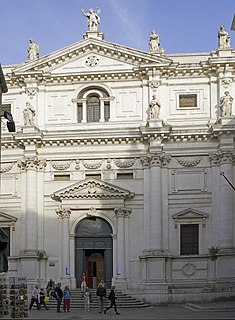
The Chiesa di San Salvatore is a church in Venice, northern Italy. Known in Venetian as San Salvador, is located on the Campo San Salvador, along the Merceria, the main shopping street of Venice. The church was first consecrated in 1177 by Pope Alexander III shortly after his reconciliation with Emperor Frederick Barbarossa at nearby San Marco. The present church, however, was begun in around 1508 by Giorgio Spavento and continued after his death the following year by Tullio Lombardo, Vincenzo Scamozzi and possibly Jacopo Sansovino. They built a large hall church, formed from three Greek crosses placed end to end. Each has a dome with a lantern to let light into the cavernous interior. The facade was added in 1663 by Giuseppe Sardi.
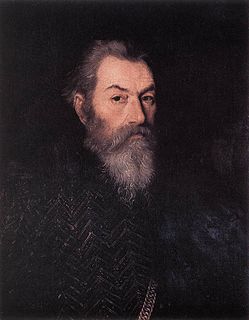
Paolo Farinati was an Italian painter of the Mannerist style, active in mainly in his native Verona, but also in Mantua and Venice.
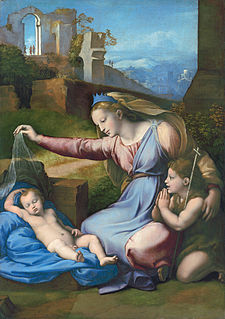
Gianfrancesco Penni (1488/1496–1528), also known as Giovan Francesco, was an Italian painter. His brother Bartolommeo was an artist of the Tudor court of Henry VIII, and another brother, Luca, ended up as one of the Italian artists of the School of Fontainebleau.
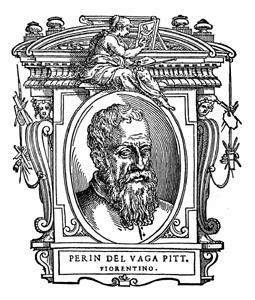
Perinodel Vaga was an Italian painter and draughtsman of the Late Renaissance/Mannerism.

Camillo Procaccini was an Italian painter. He has been posthumously referred to as the Vasari of Lombardy, for his prolific Mannerist fresco decoration.
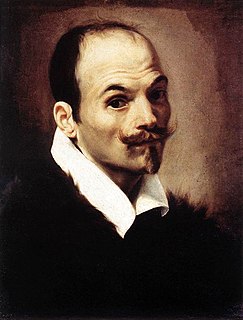
Orazio Borgianni was an Italian painter and etcher of the Mannerist and early-Baroque periods. He was the stepbrother of the sculptor and architect Giulio Lasso.

Giovanni Battista Bertani (1516–1576) was an Italian painter and architect of the late Renaissance period. He trained with Giulio Romano in Mantua, and was promoted after Romano's death to the post of prefect of the ducal studio (fabbriche). Painters who assisted him over the years include his brother Domenico, as well as Giovanni Battista del Moro, Geronimo Mazzuola, Paolo Farinato, Domenico Brusasorci, Giulio Campi, and Paolo Veronese. He is said to have completed a partial translation of the work of Vitruvius.

Paolo Landriani (1757–1839) was an Italian painter and architect.

Giulio Licinio was an Italian painter of the Renaissance period. He was born in the town of Pordenone and is said to have been a nephew of the painter il Pordenone, and brother of Giovanni Antonio. He painted in Augsburg as late as 1561, and he is thought to have died there.
Giulio Raibolini (1487–1540) also called Giulio Francia was an Italian painter of the Renaissance. He was the younger son and pupil of Francesco Raibolini. He worked jointly with his brother Giacomo on paintings.

Giulio Mazzoni (1525–1618) was an Italian painter and stuccoist, active during the Renaissance period. He was born in Piacenza, but studied in Rome under Daniele da Volterra, and was active about the year 1568. He helped decorate the Palazzo Spada. He also painted a canvas of the Four Evangelists for the Cathedral of Piacenza.
Girolamo Amalteo was a 16th-century Italian artist, the brother of Pomponio Amalteo.

Battista del Moro was an Italian painter of the Renaissance period active in his native Verona, as well as in Mantua and Venice.
Marco Angolo del Moro,, the son and pupil and assistant of Battista, flourished in the latter half of the 16th century at Venice and Verona. He assisted his father in his wall decorations at Murano. He also practised the art of engraving with considerable success.

Ercole dell'Abate or dell'Abbate (1573–1613) was an Italian mannerist painter in his native Modena. In English, his name is sometimes given as Ercole Abbate, Abate or Abati.

Giuseppe Caronia was an Italian politician.
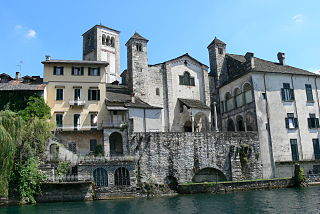
The Basilica di San Giulio is a Roman Catholic church on the small Isola San Giulio in the center of Lake Orta, province of Novara, north-western Italy. It has the status of a minor basilica. Although the island is part of the Orta San Giulio municipality, the basilica belongs to the San Giacomo parish, including the island and a portion of the west coast of the lake in San Maurizio d'Opaglio municipality.
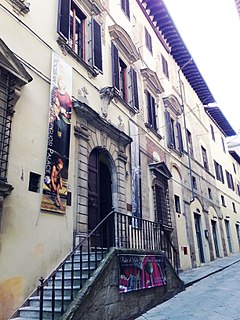
The Palazzo Rospigliosi a Ripa del Sale or Rospigliosi sulla Ripa is a former aristocratic palace located at Via Ripa del Sale number 3 in central Pistoia, Tuscany, Italy. The location is in a small alley adjacent to the Pistoia Cathedral, within the most ancient set of city walls. In the 19th century, the palace was donated to the diocese and now is used as both Diocesan museum and for the display of the collection donated by Clemente Rospigliosi.

The Andreotti IV Cabinet, led by Giulio Andreotti, was the 34th cabinet of the Italian Republic.

















